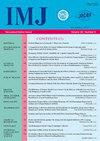冠状病毒疾病严重程度预后的主要预测因素
Q4 Medicine
引用次数: 0
摘要
冠状病毒病的临床症状多种多样,从无症状到严重甚至危重。迄今为止,关于这种疾病的流行病学、临床特征、预防和治疗的资料不足,需要进一步研究这一问题。为了个性化治疗,重要的是确定主要的临床和实验室预测指标,以预测COVID - 19的严重程度。患者的检查算法包括所有投诉的评估,疾病的记忆数据,流行病学的记忆。确定患者病情严重程度的临床检查包括体格检查、使用核酸扩增和/或酶联免疫吸附测定方法的诊断材料之一、脉搏血氧测定。实验室、病原学诊断、测试和抗体起着重要作用。中度、重度和极重度感染患者住院时,需要进行临床研究,如:一般(临床)及生化血液检查、凝血图、弥散性血管内凝血综合征诊断、危险因素识别等。仪器和放射学诊断包括:脉搏血氧仪测量SpO2水平,肺和胸膜腔的计算机断层扫描和超声检查,心电图。综合评估患者的临床和实验室数据,可以确定临床确诊的COVID - 19,及时确定患者路线并开始综合治疗。乌克兰实验室在SARS - CoV - 2 RNA活性上引入聚合酶链反应定量诊断方法是一个有希望的方向,这将有助于个体化患者的病毒载量程度,改善治疗控制。关键词:COVID - 19;病程严重程度预测因素;实验室诊断方法;本文章由计算机程序翻译,如有差异,请以英文原文为准。
MAIN PREDICTORS OF CORONAVIRUS DISEASE SEVERITY PROGNOSIS
Coronavirus disease can have a variety of clinical symptoms, ranged from asymptomatic to severe and even critical ones. To date, an information on the epidemiology, clinical features, prevention and treatment of this disease is insufficient, which requires a further study of the problem. To personalize the treatment, it is important to determine the leading clinical and laboratory predictors to forecast the severity of COVID−19. The algorithm of examination of a patient includes the assessment of all complaints, data of the anamnesis of the disease, epidemiological anamnesis. The combination of clinical examination to determine the severity of the patient's condition includes physical examination, the one of diagnostic material using methods of nucleic acid amplification and / or enzyme−linked immunosorbent assay, pulse oximetry. Laboratory, etiological diagnostics, tests and antibodies play an important role. In case of hospitalization of the patients with moderate, severe and extremely severe infection, clinical studies are required such as: general (clinical) and biochemical blood test, coagulogram, diagnosis of disseminated intravascular coagulation syndrome, as well as identification of risk factors. Instrumental and radiological diagnostics include: pulse oximetry with measurement of SpO2 level, computed tomography and ultrasound examination of lungs and pleural cavities, electrocardiography. Comprehensive evaluation of clinical and laboratory data of patients allows to determine a clinically confirmed COVID−19, to route the patient and to start complex therapy in time. A promising direction is the introduction of the method of quantitative diagnostics by polymerase chain reaction on SARS−CoV−2 RNA in the activity of laboratories of Ukraine, which will help to individualize the degree of viral load in patients, improve treatment control.
Key words: COVID−19, predictors of course severity, methods of laboratory diagnostics, quantitative polymerase chain reaction.
求助全文
通过发布文献求助,成功后即可免费获取论文全文。
去求助
来源期刊

International Medical Journal
医学-医学:内科
自引率
0.00%
发文量
21
审稿时长
4-8 weeks
期刊介绍:
The International Medical Journal is intended to provide a multidisciplinary forum for the exchange of ideas and information among professionals concerned with medicine and related disciplines in the world. It is recognized that many other disciplines have an important contribution to make in furthering knowledge of the physical life and mental life and the Editors welcome relevant contributions from them.
The Editors and Publishers wish to encourage a dialogue among the experts from different countries whose diverse cultures afford interesting and challenging alternatives to existing theories and practices. Priority will therefore be given to articles which are oriented to an international perspective. The journal will publish reviews of high quality on contemporary issues, significant clinical studies, and conceptual contributions, as well as serve in the rapid dissemination of important and relevant research findings.
The International Medical Journal (IMJ) was first established in 1994.
 求助内容:
求助内容: 应助结果提醒方式:
应助结果提醒方式:


